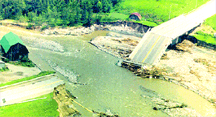
Natural Resources Canada > Earth Sciences Sector > Priorities > Climate Change Impacts and Adaptation > Climate Change in Canada
A change in the wind: Climate Change in Québec Extreme weather: what are the risks?
Did you know?
Flooding affects over 80% of waterfront municipalities and costs an average of $10 million to $15 million annually. Floods, which occur most frequently in the southern part of the province, are the most common type of natural catastrophe in Quebec.

July 1996
Catastrophic flooding in the Saguenay
(François Morneau, Transports Québec) |
Climate anomalies have occurred in the past and are simply part of the intrinsic characteristics of past and present climate. But what form will they take given a future climate altered by human activities?

January 1998
Half the population of Quebec is left without power in the wake of an ice storm
(Hydro-Québec) |
Recent violent weather events may be completely natural phenomena. However, we cannot dismiss the possibility that the climate is changing. Studies suggest that these extreme events are in many ways illustrative of the type of situation that could be generated by global warming.
These are only two examples of extreme weather, but every region of Quebec is vulnerable to such events.
The projected climate change could result in an increased number of violent summer events because a warmer, wetter climate is conducive to the development of severe thunderstorms. Moreover, regions that have thus far escaped relatively unscathed could also be affected. The potential consequences are numerous, for both inhabited areas (e.g. more frequent flash floods) and natural ecosystems, where forest fires caused by lightning could become more frequent occurrences.

Montréal thunderstorm
(Robin Tremblay) |
Climate change also implies a decrease in the number of intense cold waves, which should meet with widespread approval. It also implies an increase in the number of winter warm spells and thaws. This could mean more frequent rainstorms during winter, bringing flooding and causing more potholes to plague beleaguered motorists...
Did you know?
In summer, the parts of Quebec most affected by violent weather phenomena are the regions of Montréal and Montérégie, where over 20 events - violent winds, torrential rains and flooding, and hail - are reported each year.
| 